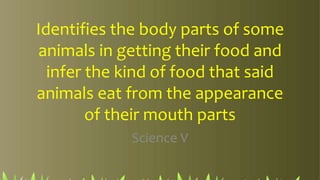2nd qtr 3 body parts of some animals in getting their food
•Download as PPTX, PDF•
16 likes•23,947 views
This document discusses how an animal's mouth parts indicate what type of food it eats. Animals with flat teeth grind and chew plants, while meat-eaters have sharp pointed teeth for tearing meat. Seed-eaters have hard beaks without teeth to crack seeds. Some animals like mosquitoes have tube-like mouths called proboscises for sucking. Frogs use their long sticky tongues to catch food.
Report
Share
Report
Share

Recommended
More Related Content
What's hot
What's hot (20)
Animals in the locality, body parts of animals, Special body parts of animals

Animals in the locality, body parts of animals, Special body parts of animals
Animal Habitat - Land, Water, and Both Land and Water

Animal Habitat - Land, Water, and Both Land and Water
Viewers also liked
Viewers also liked (20)
2nd qtr 4 classifies animals according to the food they eat

2nd qtr 4 classifies animals according to the food they eat
Similar to 2nd qtr 3 body parts of some animals in getting their food
Similar to 2nd qtr 3 body parts of some animals in getting their food (20)
Q2-Week2- Body Structures of Amimals that Help them Adapt and Survive - Copy....

Q2-Week2- Body Structures of Amimals that Help them Adapt and Survive - Copy....
ANIMAL STRUCTURE AND FUNCTIONS- NUTRITION AND DENTITION.pptx

ANIMAL STRUCTURE AND FUNCTIONS- NUTRITION AND DENTITION.pptx
science wizards will compete, science quiz bee finals

science wizards will compete, science quiz bee finals
More from Shirley Sison
More from Shirley Sison (20)
2nd qtr 12 using the future tense of the verb with

2nd qtr 12 using the future tense of the verb with
2nd qtr 11 use the expression used to with the simple

2nd qtr 11 use the expression used to with the simple
2nd qtr 10 using the simple present for general truth

2nd qtr 10 using the simple present for general truth
2nd qtr 8 identifying the key sentence in a paragraph

2nd qtr 8 identifying the key sentence in a paragraph
2nd qtr 6 asking and answering questions using rejoinders

2nd qtr 6 asking and answering questions using rejoinders
2nd qtr 3 body parts of some animals in getting their food
- 1. Identifies the body parts of some animals in getting their food and infer the kind of food that said animals eat from the appearance of their mouth parts Science V
- 2. What do body parts tell about an animals? Review
- 3. How animals in your locality get their food? Checking of Assignment:
- 4. Why does a giraffe have a long neck? Motivation
- 5. By looking at the picture choose one animal and tell what that animal used in getting its food. Presentation
- 6. Different animals have different mouth parts. The appearance of their mouth parts indicate the kind of food they eat. Animals that eat plants have flat teeth that are used for grinding and chewing. Text Reading
- 7. In contrast, meat-eating animals have strong, sharp, and pointed teeth that are used for tearing meat into smaller pieces. Text Reading
- 8. Animals that pick up and crack seeds have hard beaks. They do not have teeth. Text Reading
- 9. A mouth part that is used for sucking looks like a long tube. This thin tube is called proboscis. Text Reading
- 10. The frog has a long tongue fastened at the front of its mouth. This tongue is sticky and pops out to catch food. Text Reading
- 11. 1. What food-getting adaptation does each animal in the picture have? 2. What food does it eat? 3. Give examples of other animals and tell what body part they use in getting their food. Concept Formation
- 12. What does the appearance of an animal’s mouth part reveal? Generalization
- 13. Give one example of animal and tell the body part of that animal in getting its food and the kind of food that it eats. Use the simple form of the verb in your sentences. Application
- 14. Choose the letter of the correct answer. 1. Which of theses animals has mouth parts used for sucking? a. carabao c. mosquito b. horse d. birds 2. What kind of mouth part does a frog have? a. flat teeth c. sharp tongue b. tube-like d. sticky tongue that structure pops out Evaluation
- 15. 3. What structure is found in the mouth part of the bird? a. beak c. proboscis b. teeth d. sticky tongue 4. What kind of teeth do humans have? a. sharp teeth c. flat and sharp b. flat d. round and sharp 5. How do dogs, lions, and monkeys use their teeth? a. for chewing c. for grinding b. for mashing d. for cutting & tearing
- 16. Name all animals that use their claws to get their food. Assignment
